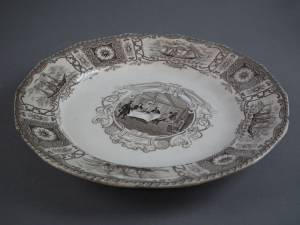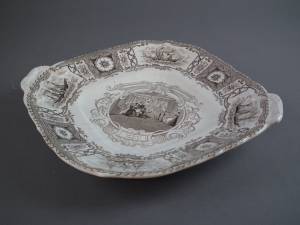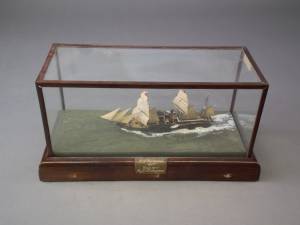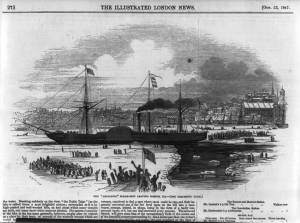An online project under the direction of the CAPE ANN MUSEUM
Historical Materials: Vessels (Specific / Named)
Historical Materials » Vessels (Specific / Named) » "Britannia" (Cunard Steamship)
You have navigated to this pages from catalog entry: Cunard Steamship Entering Boston Harbor (inv. 197)
"Britannia" (Cunard Steamship)
View related Fitz Henry Lane catalog entries (4) »
Samuel Cunard founded the Cunard Line in 1840. Four new liners were commissioned, to be launched on February 5. The first of the new class was called "Britannia"; three sisters of "Britannia" were "Acadia," "Caledonia," and "Columbia." The "Britannia" was a side-wheel steamship with a barkentine rig (square-rigged on the foremast; fore-and-aft rigged on the main and mizzen masts). She also had an orange-red straight funnel, and luxurious interiors.The sails were for steadying her motion in heavy seas, maintaining headway, and staying on course if the engines broke down.
The liner operated on a regular schedule. She was built on the Clyde in Glasgow and arrived in Liverpool in June 1840. She departed on July 4 and arrived in Boston July 17. She was berthed at the specifically designed "Cunard Wharf" to great excitement in Boston. Charles Dickens, his wife Kate, and their maid were passengers for the crossing in January 1842. In January 1844, Boston Harbour froze and trapped the ship as she was about to leave for Liverpool. A seven-mile channel was created to free her so that she could keep to her schedule. Her final crossing was in 1848, when she was sold to the German navy.
"Britannia" statistics: 207 feet long; 1,139 tons; 9 knot service speed; 115 passengers.
Related tables: Boston – Boston Artists Association » // Boston – Oakes Music Store » // Cleland, Captain Richard » // Steamship / Engine-Powered Vessel / Coastal Steamer »
overall: 190 x 110 mm
National Maritime Museum, Greenwich
PLT 0200, 0201, 0202, 0203
One of a pair of American silver goblets presented to Captain John C. Hewitt by the passengers of the "Britannia" steamship.
A four-piece wine set with its original wooden carrying case presented to Captain John C. Hewitt by the passengers of the 'Britannia' steamship, 1842. The goblet is on a foliate-chased rising circular base, with a balaster stem and moulded rim, the bowl chased with rising acanthus leaves. It is inscribed: "Presented to Capt. John Hewett [sic] of the Britannia Steamship by the passengers, January 1842"; the base has a wooden inset covered in red baize. The wine set was presented to Captain Hewitt on January 29, 1842 in the Tremont Theatre, Boston. Charles Dickens wrote an account of his stormy transatlantic crossing on board the "Britannia" in the second chapter of American Notes (1842).
17 1/4 x 24 7/8 in.
American Antiquarian Society, Worcester, Mass.
Also filed under: Boston Harbor » // Bouvé & Sharp, Lith. – Boston » // De Vaudricourt, Augustus » // Sharp's, J. C., Lith. – Boston »
5.6.1841
Newspaper
p. 2 col. 1
"Arrival of the Britannia.
12 days later from England.
Highly Important from China: Great Fall in the Price of Teas: Great Excitement in Relation to the Non-Arrival of the Steamer President.
The Royal Mail steamship Britannia, Capt R. B. Cleland, arrived at this port this morning, at 2' clock, from Liverpool, having left on the 20th ult. at 12 M. She ran 200 miles to the south of her course, to avoid the ice, which lengthened her passage. Arrived at Halifax on Tuesday morning, and left at 1 P.M., making her passage to Boston in 38 hours. She had 87 passengers to Halifax, landed 56, and took in 9 additional for Boston."
Also filed under: Cleland, Captain Richard » // Newspaper / Journal Articles »
Newspaper
p.3
"...On the 25th, 26th, and 27th, the Britannia experienced very severe gales, and on Sunday the 26th she shipped a sea which stove the bulwarks on the larboard bow, and broke the leg of one of the crew..."
Also filed under: Newspaper / Journal Articles »
Newspaper
col.1
"The Britannia arrived out on the 29th... the fastest passage ever made..."
Also filed under: Newspaper / Journal Articles »
Newspaper
p. 2 col. 2
"There is a beautiful painting exhibiting at the window of W. H. Oakes's music store, No. 13 Tremont Row. It represents the steamship Britannia during the most terrific gale she ever encountered. It was on the morning of the 23d of April last, on her passage from Liverpool to this port. The picture was painted expressly for Capt. Cleland, by Mr F.H. Lane, one of the best painters of sea views in the country."
"Vesting and Pantaloon Stuffs Per Steamer Britannia"
Also filed under: Newspaper / Journal Articles »
"It is the third morning. I am awakened out of my sleep by a dismal shriek from my wife who demands to know whether there's any danger. I rouse myself and look out of bed. The water jug is plunging and leaping like a lively dolphin; all the smaller articles are afloat except my shoes which are stranded on a carpet bag high and dry, like a couple of coal barges. Suddenly I behold them spring into the air and see the looking glass, which is nailed to the wall, sticking fast upon the ceiling. At the same time the door entirely disappears and a new one is opened in the floor. Then I begin to comprehend that the state room is standing on its head.
Before it is possible to make any arrangement at all compatible with this novel state of things, the ship rights. Before one can say: 'Thank Heaven!' she wrongs again. Before one can cry: 'She is wrong' she seems to have started forward and to be a creature actively running of its own accord, with broken knees and failing legs, through every variety of hole and pitfall, and stumbling constantly. Before one can so much as wonder, she takes a high leap into the air. Before she has well done that, she takes a deep dive into the water. Before she has gained the surface, she throws a somerset. The instant she is on her legs, she rushes backward. And so she goes on, staggering, heaving, wrestling, leaping, diving, jumping, pitching, throbbing, rolling and rocking, and going through all these movements sometimes by turns and sometimes all together until one feels disposed to roar for mercy."
Also filed under: Chronology » // Letters »
lithograph
15 x 25 in (38.1 x 63.5 cm)
Peabody Essex Museum
Also filed under: Bouvé & Sharp, Lith. – Boston »
Pottery
9 in (22.86 cm)
M3233
Peabody Essex Museum
This China was issued to celebrate the establishment of the British and North American Royal Mail Steam Packet Company, which later became Cunard. Some might have been used on board Britannia and the other three ships depicted.
Ship model
50'/1"
M15732
Peabody Essex Museum
Also filed under: Objects »
Library of Congress Catalog Number 2004671768
Also filed under: Boston Harbor »
















